British Airways: Logistics, Web Information Systems, and Processes
VerifiedAdded on 2020/04/21
|49
|11800
|181
Report
AI Summary
This academic paper analyzes how British Airways' web information systems (WIS) align with its real-world logistics operations and customer expectations. The research explores the integration of ICT within the airline industry, focusing on British Airways' specific implementations. The study examines various WIS tools, their link to business processes, and their impact on market competitiveness. The report includes a literature review of relevant studies, a detailed methodology outlining the research approach, and an analysis of the findings. The paper identifies the importance of WIS, its integration within BA's operations, and its role in sustaining market competitiveness, while also acknowledging research limitations and suggesting future research directions. The report also explores the impact of web information systems on British Airways' sustainability.
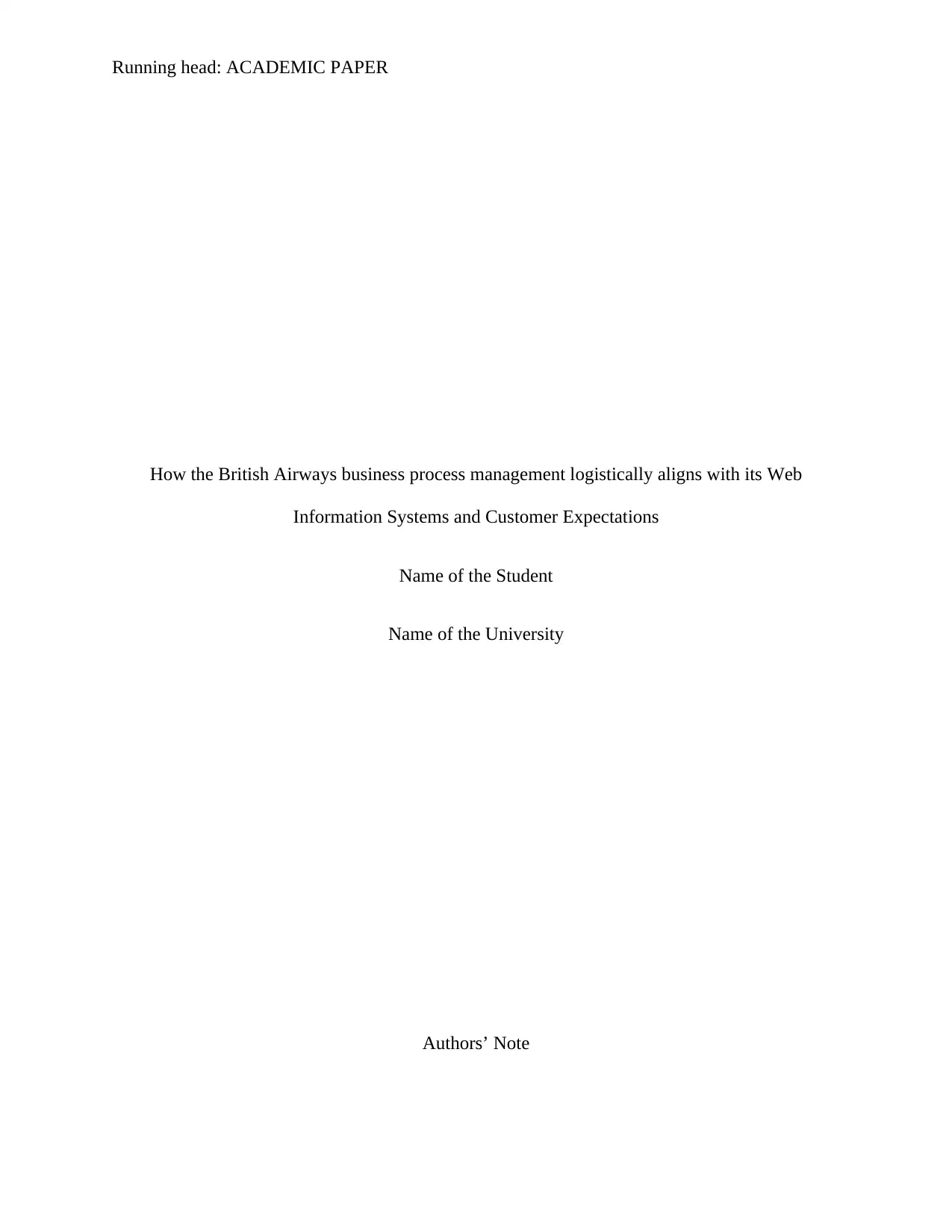
Running head: ACADEMIC PAPER
How the British Airways business process management logistically aligns with its Web
Information Systems and Customer Expectations
Name of the Student
Name of the University
Authors’ Note
How the British Airways business process management logistically aligns with its Web
Information Systems and Customer Expectations
Name of the Student
Name of the University
Authors’ Note
Paraphrase This Document
Need a fresh take? Get an instant paraphrase of this document with our AI Paraphraser
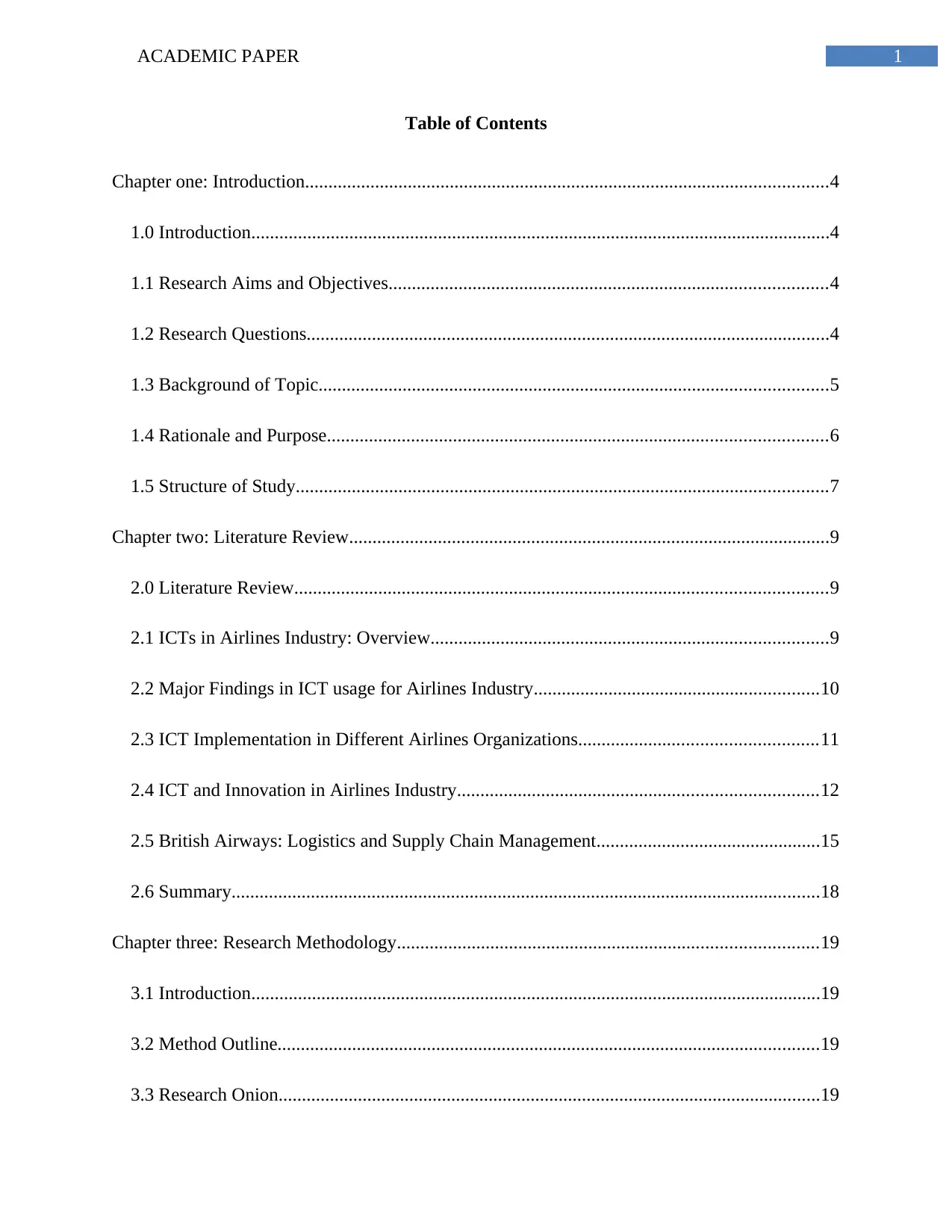
1ACADEMIC PAPER
Table of Contents
Chapter one: Introduction................................................................................................................4
1.0 Introduction............................................................................................................................4
1.1 Research Aims and Objectives..............................................................................................4
1.2 Research Questions................................................................................................................4
1.3 Background of Topic.............................................................................................................5
1.4 Rationale and Purpose...........................................................................................................6
1.5 Structure of Study..................................................................................................................7
Chapter two: Literature Review.......................................................................................................9
2.0 Literature Review..................................................................................................................9
2.1 ICTs in Airlines Industry: Overview.....................................................................................9
2.2 Major Findings in ICT usage for Airlines Industry.............................................................10
2.3 ICT Implementation in Different Airlines Organizations...................................................11
2.4 ICT and Innovation in Airlines Industry.............................................................................12
2.5 British Airways: Logistics and Supply Chain Management................................................15
2.6 Summary..............................................................................................................................18
Chapter three: Research Methodology..........................................................................................19
3.1 Introduction..........................................................................................................................19
3.2 Method Outline....................................................................................................................19
3.3 Research Onion....................................................................................................................19
Table of Contents
Chapter one: Introduction................................................................................................................4
1.0 Introduction............................................................................................................................4
1.1 Research Aims and Objectives..............................................................................................4
1.2 Research Questions................................................................................................................4
1.3 Background of Topic.............................................................................................................5
1.4 Rationale and Purpose...........................................................................................................6
1.5 Structure of Study..................................................................................................................7
Chapter two: Literature Review.......................................................................................................9
2.0 Literature Review..................................................................................................................9
2.1 ICTs in Airlines Industry: Overview.....................................................................................9
2.2 Major Findings in ICT usage for Airlines Industry.............................................................10
2.3 ICT Implementation in Different Airlines Organizations...................................................11
2.4 ICT and Innovation in Airlines Industry.............................................................................12
2.5 British Airways: Logistics and Supply Chain Management................................................15
2.6 Summary..............................................................................................................................18
Chapter three: Research Methodology..........................................................................................19
3.1 Introduction..........................................................................................................................19
3.2 Method Outline....................................................................................................................19
3.3 Research Onion....................................................................................................................19
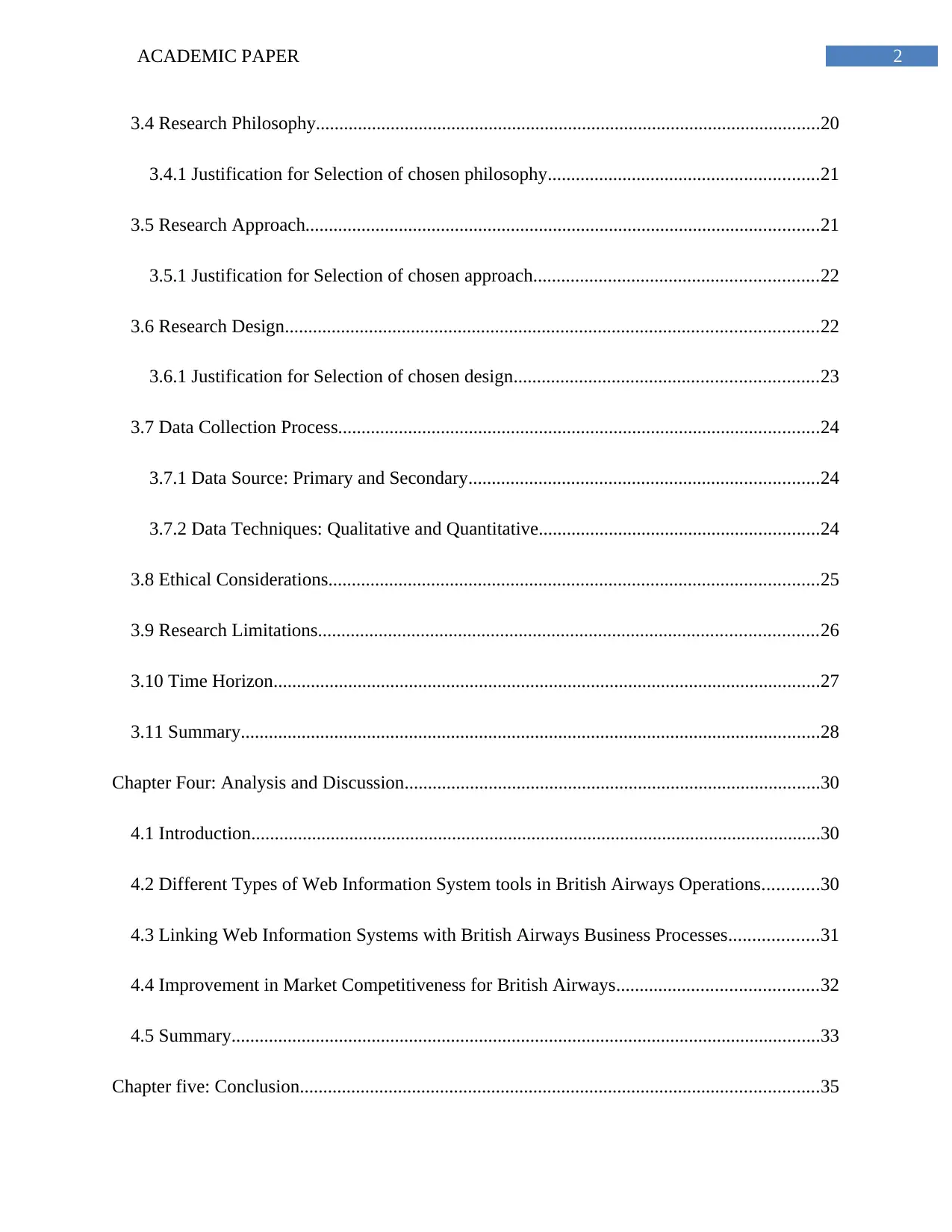
2ACADEMIC PAPER
3.4 Research Philosophy............................................................................................................20
3.4.1 Justification for Selection of chosen philosophy..........................................................21
3.5 Research Approach..............................................................................................................21
3.5.1 Justification for Selection of chosen approach.............................................................22
3.6 Research Design..................................................................................................................22
3.6.1 Justification for Selection of chosen design.................................................................23
3.7 Data Collection Process.......................................................................................................24
3.7.1 Data Source: Primary and Secondary...........................................................................24
3.7.2 Data Techniques: Qualitative and Quantitative............................................................24
3.8 Ethical Considerations.........................................................................................................25
3.9 Research Limitations...........................................................................................................26
3.10 Time Horizon.....................................................................................................................27
3.11 Summary............................................................................................................................28
Chapter Four: Analysis and Discussion.........................................................................................30
4.1 Introduction..........................................................................................................................30
4.2 Different Types of Web Information System tools in British Airways Operations............30
4.3 Linking Web Information Systems with British Airways Business Processes...................31
4.4 Improvement in Market Competitiveness for British Airways...........................................32
4.5 Summary..............................................................................................................................33
Chapter five: Conclusion...............................................................................................................35
3.4 Research Philosophy............................................................................................................20
3.4.1 Justification for Selection of chosen philosophy..........................................................21
3.5 Research Approach..............................................................................................................21
3.5.1 Justification for Selection of chosen approach.............................................................22
3.6 Research Design..................................................................................................................22
3.6.1 Justification for Selection of chosen design.................................................................23
3.7 Data Collection Process.......................................................................................................24
3.7.1 Data Source: Primary and Secondary...........................................................................24
3.7.2 Data Techniques: Qualitative and Quantitative............................................................24
3.8 Ethical Considerations.........................................................................................................25
3.9 Research Limitations...........................................................................................................26
3.10 Time Horizon.....................................................................................................................27
3.11 Summary............................................................................................................................28
Chapter Four: Analysis and Discussion.........................................................................................30
4.1 Introduction..........................................................................................................................30
4.2 Different Types of Web Information System tools in British Airways Operations............30
4.3 Linking Web Information Systems with British Airways Business Processes...................31
4.4 Improvement in Market Competitiveness for British Airways...........................................32
4.5 Summary..............................................................................................................................33
Chapter five: Conclusion...............................................................................................................35
⊘ This is a preview!⊘
Do you want full access?
Subscribe today to unlock all pages.

Trusted by 1+ million students worldwide

3ACADEMIC PAPER
5.1 Summary of Outcomes........................................................................................................35
5.2 Alignment with Objectives..................................................................................................36
5.2.1 Identification of the Web Information System process, and how real-world Logistics
align with organization’s business process: Major Implications...........................................36
5.2.2 Highlighting the impact of Web Information Systems in British Airways Business
Process: Major Implications..................................................................................................37
5.2.3 Identification the relationship between Web information systems and British Airways
Sustainability: Major Implications........................................................................................38
5.3 Research Limitations and Future Scope..............................................................................38
References......................................................................................................................................40
5.1 Summary of Outcomes........................................................................................................35
5.2 Alignment with Objectives..................................................................................................36
5.2.1 Identification of the Web Information System process, and how real-world Logistics
align with organization’s business process: Major Implications...........................................36
5.2.2 Highlighting the impact of Web Information Systems in British Airways Business
Process: Major Implications..................................................................................................37
5.2.3 Identification the relationship between Web information systems and British Airways
Sustainability: Major Implications........................................................................................38
5.3 Research Limitations and Future Scope..............................................................................38
References......................................................................................................................................40
Paraphrase This Document
Need a fresh take? Get an instant paraphrase of this document with our AI Paraphraser
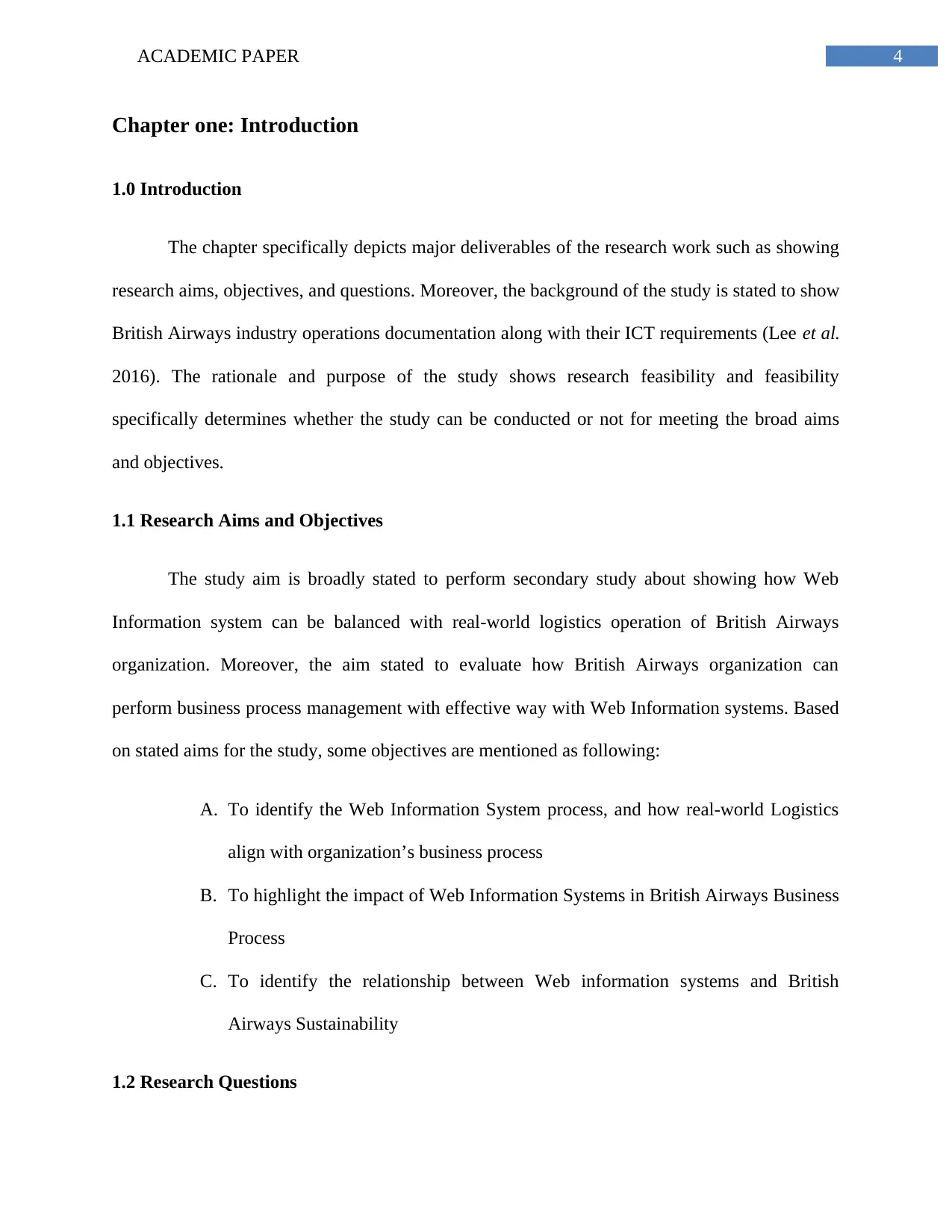
4ACADEMIC PAPER
Chapter one: Introduction
1.0 Introduction
The chapter specifically depicts major deliverables of the research work such as showing
research aims, objectives, and questions. Moreover, the background of the study is stated to show
British Airways industry operations documentation along with their ICT requirements (Lee et al.
2016). The rationale and purpose of the study shows research feasibility and feasibility
specifically determines whether the study can be conducted or not for meeting the broad aims
and objectives.
1.1 Research Aims and Objectives
The study aim is broadly stated to perform secondary study about showing how Web
Information system can be balanced with real-world logistics operation of British Airways
organization. Moreover, the aim stated to evaluate how British Airways organization can
perform business process management with effective way with Web Information systems. Based
on stated aims for the study, some objectives are mentioned as following:
A. To identify the Web Information System process, and how real-world Logistics
align with organization’s business process
B. To highlight the impact of Web Information Systems in British Airways Business
Process
C. To identify the relationship between Web information systems and British
Airways Sustainability
1.2 Research Questions
Chapter one: Introduction
1.0 Introduction
The chapter specifically depicts major deliverables of the research work such as showing
research aims, objectives, and questions. Moreover, the background of the study is stated to show
British Airways industry operations documentation along with their ICT requirements (Lee et al.
2016). The rationale and purpose of the study shows research feasibility and feasibility
specifically determines whether the study can be conducted or not for meeting the broad aims
and objectives.
1.1 Research Aims and Objectives
The study aim is broadly stated to perform secondary study about showing how Web
Information system can be balanced with real-world logistics operation of British Airways
organization. Moreover, the aim stated to evaluate how British Airways organization can
perform business process management with effective way with Web Information systems. Based
on stated aims for the study, some objectives are mentioned as following:
A. To identify the Web Information System process, and how real-world Logistics
align with organization’s business process
B. To highlight the impact of Web Information Systems in British Airways Business
Process
C. To identify the relationship between Web information systems and British
Airways Sustainability
1.2 Research Questions
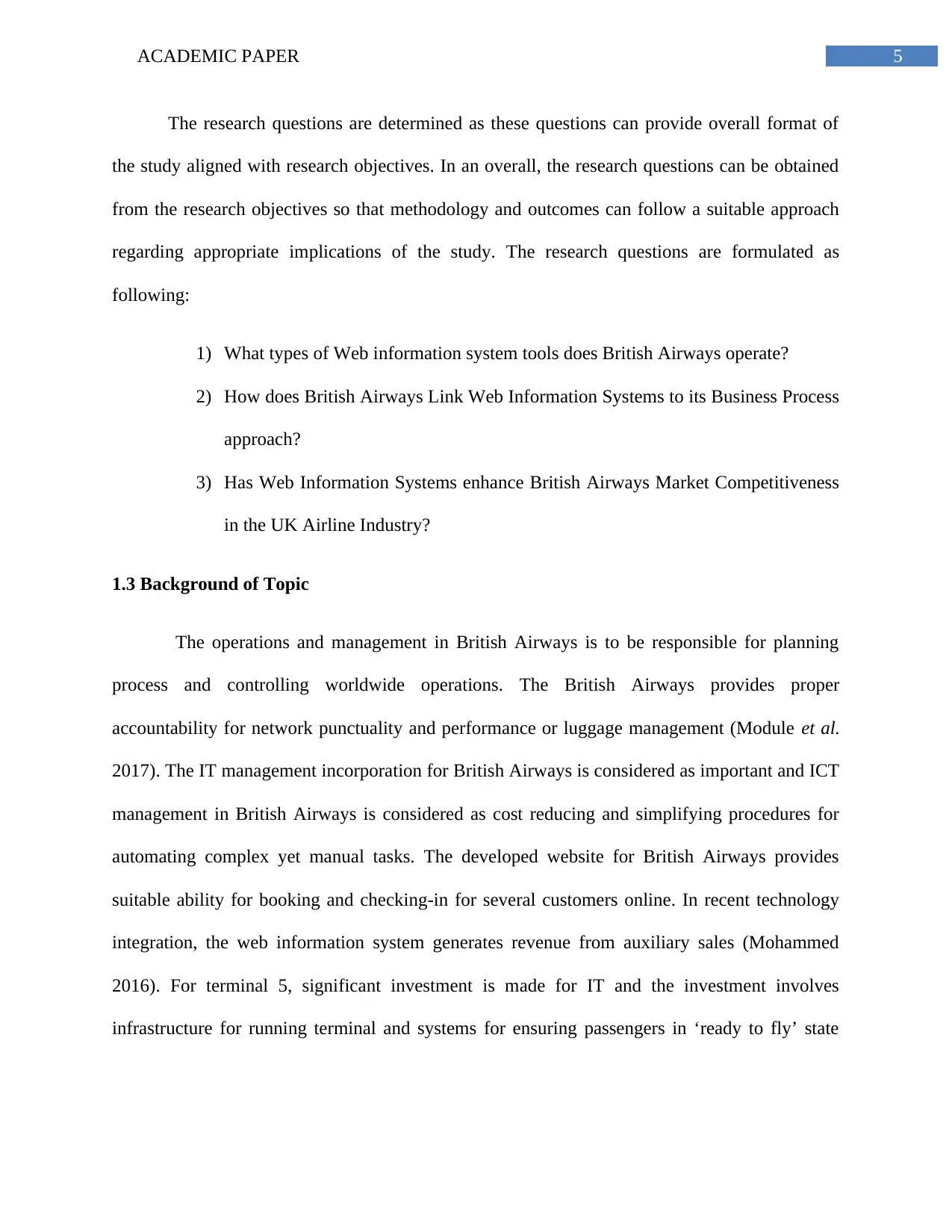
5ACADEMIC PAPER
The research questions are determined as these questions can provide overall format of
the study aligned with research objectives. In an overall, the research questions can be obtained
from the research objectives so that methodology and outcomes can follow a suitable approach
regarding appropriate implications of the study. The research questions are formulated as
following:
1) What types of Web information system tools does British Airways operate?
2) How does British Airways Link Web Information Systems to its Business Process
approach?
3) Has Web Information Systems enhance British Airways Market Competitiveness
in the UK Airline Industry?
1.3 Background of Topic
The operations and management in British Airways is to be responsible for planning
process and controlling worldwide operations. The British Airways provides proper
accountability for network punctuality and performance or luggage management (Module et al.
2017). The IT management incorporation for British Airways is considered as important and ICT
management in British Airways is considered as cost reducing and simplifying procedures for
automating complex yet manual tasks. The developed website for British Airways provides
suitable ability for booking and checking-in for several customers online. In recent technology
integration, the web information system generates revenue from auxiliary sales (Mohammed
2016). For terminal 5, significant investment is made for IT and the investment involves
infrastructure for running terminal and systems for ensuring passengers in ‘ready to fly’ state
The research questions are determined as these questions can provide overall format of
the study aligned with research objectives. In an overall, the research questions can be obtained
from the research objectives so that methodology and outcomes can follow a suitable approach
regarding appropriate implications of the study. The research questions are formulated as
following:
1) What types of Web information system tools does British Airways operate?
2) How does British Airways Link Web Information Systems to its Business Process
approach?
3) Has Web Information Systems enhance British Airways Market Competitiveness
in the UK Airline Industry?
1.3 Background of Topic
The operations and management in British Airways is to be responsible for planning
process and controlling worldwide operations. The British Airways provides proper
accountability for network punctuality and performance or luggage management (Module et al.
2017). The IT management incorporation for British Airways is considered as important and ICT
management in British Airways is considered as cost reducing and simplifying procedures for
automating complex yet manual tasks. The developed website for British Airways provides
suitable ability for booking and checking-in for several customers online. In recent technology
integration, the web information system generates revenue from auxiliary sales (Mohammed
2016). For terminal 5, significant investment is made for IT and the investment involves
infrastructure for running terminal and systems for ensuring passengers in ‘ready to fly’ state
⊘ This is a preview!⊘
Do you want full access?
Subscribe today to unlock all pages.

Trusted by 1+ million students worldwide

6ACADEMIC PAPER
before they reach airport. Self-service check-in can reduce passenger queue and improve airport
service experience for customers.
ICT transformed way of interaction for staffs and employee self service (ESS) program
improved service profiles. Most of the staffs utilize ESS program in every month and system will
be a place for finding out information and systems for accomplishing the job (Al-Dori 2017). IT
can pose major role to help managing environmental impact; power used from datacenter that
remained as decreasing number of processors for use. Notebook laptops used as resources
increased efficiency in power usage (at least 70%) and personal computers are powered off at
night (Luster 2017; Laudon and Laudon 2016). The background problem states that British
Airways logistics operation is not properly aligned with web information systems and in existing
situation, this paper proposes a suitable research approach for finding out importance of web
information system, appropriate integration of web information systems, and sustaining
competitiveness in market.
1.4 Rationale and Purpose
British Airways faced major problem as due to system operation being much more
advanced than earlier operational systems; in near future, there will be potential decline in
employing people in workforce. This means the organization will soon be dependent and entirely
reliant on systems as those systems can take over personnel ability throughout using artificial
intelligence. However, one thing is to be thought thoroughly that those operational systems
cannot be operated without logical reasoning for handling several issues encountered along with
solving issues logically. In current scenario, web information systems are embraced for
individual parts of business, however without this particular study stating the alignment between
before they reach airport. Self-service check-in can reduce passenger queue and improve airport
service experience for customers.
ICT transformed way of interaction for staffs and employee self service (ESS) program
improved service profiles. Most of the staffs utilize ESS program in every month and system will
be a place for finding out information and systems for accomplishing the job (Al-Dori 2017). IT
can pose major role to help managing environmental impact; power used from datacenter that
remained as decreasing number of processors for use. Notebook laptops used as resources
increased efficiency in power usage (at least 70%) and personal computers are powered off at
night (Luster 2017; Laudon and Laudon 2016). The background problem states that British
Airways logistics operation is not properly aligned with web information systems and in existing
situation, this paper proposes a suitable research approach for finding out importance of web
information system, appropriate integration of web information systems, and sustaining
competitiveness in market.
1.4 Rationale and Purpose
British Airways faced major problem as due to system operation being much more
advanced than earlier operational systems; in near future, there will be potential decline in
employing people in workforce. This means the organization will soon be dependent and entirely
reliant on systems as those systems can take over personnel ability throughout using artificial
intelligence. However, one thing is to be thought thoroughly that those operational systems
cannot be operated without logical reasoning for handling several issues encountered along with
solving issues logically. In current scenario, web information systems are embraced for
individual parts of business, however without this particular study stating the alignment between
Paraphrase This Document
Need a fresh take? Get an instant paraphrase of this document with our AI Paraphraser

7ACADEMIC PAPER
operation process of British Airways Logistics system and use of web information systems, the
importance of ICT in airlines industry cannot be depicted.
1.5 Structure of Study
Structure of the study states about considered chapters along with their individual details
that are relevant for this study. The chapters are considered as following:
Chapter 1 – Introduction: The first chapter is prepared to include particular elements of
study such as research aims, objectives, questions, and background. The introduction chapter
provides suitable platform based on which the study should be conducted.
Chapter 2 – Literature Review: The second chapter is emphasized on depicting major
secondary studies and relevant findings about ICTs in Airlines industry. In this review section,
British Airways organization is focused on context of web information system implementation as
well.
Chapter 3 – Research Methodology: In this third chapter, a particular approach and
method is stated for outlining the study structure (Doyen et al. 2016). The methodology section
is essential for determining the research design whether exploratory, descriptive or explanatory;
stating approach whether study being primary or secondary survey; and following sample
specification for primary study and reviewing previous studies for secondary study
consideration.
Chapter 4 – Data Analysis, Discussion and Interpretation: This fourth chapter is
prepared for collecting data from primary or secondary sources and including them in
appropriate format for structured data representation. The data analysis is performed in this
operation process of British Airways Logistics system and use of web information systems, the
importance of ICT in airlines industry cannot be depicted.
1.5 Structure of Study
Structure of the study states about considered chapters along with their individual details
that are relevant for this study. The chapters are considered as following:
Chapter 1 – Introduction: The first chapter is prepared to include particular elements of
study such as research aims, objectives, questions, and background. The introduction chapter
provides suitable platform based on which the study should be conducted.
Chapter 2 – Literature Review: The second chapter is emphasized on depicting major
secondary studies and relevant findings about ICTs in Airlines industry. In this review section,
British Airways organization is focused on context of web information system implementation as
well.
Chapter 3 – Research Methodology: In this third chapter, a particular approach and
method is stated for outlining the study structure (Doyen et al. 2016). The methodology section
is essential for determining the research design whether exploratory, descriptive or explanatory;
stating approach whether study being primary or secondary survey; and following sample
specification for primary study and reviewing previous studies for secondary study
consideration.
Chapter 4 – Data Analysis, Discussion and Interpretation: This fourth chapter is
prepared for collecting data from primary or secondary sources and including them in
appropriate format for structured data representation. The data analysis is performed in this

8ACADEMIC PAPER
section based on nature of the study whether being secondary and primary study; the research
analysis is different from each other based on nature (Halford 2016). Moreover, the
interpretation of analysis is conducted to show whether the findings can be suitably define the
research questions or not.
Chapter 5 – Conclusion: The final chapter is prepared for aligning objectives with study
findings. The conclusion chapter includes a summary of the outcomes from the study to present
this particular research importance. Moreover, the conclusion section determines the future scope
of the study to state how certain limitations in the study can be resolved.
section based on nature of the study whether being secondary and primary study; the research
analysis is different from each other based on nature (Halford 2016). Moreover, the
interpretation of analysis is conducted to show whether the findings can be suitably define the
research questions or not.
Chapter 5 – Conclusion: The final chapter is prepared for aligning objectives with study
findings. The conclusion chapter includes a summary of the outcomes from the study to present
this particular research importance. Moreover, the conclusion section determines the future scope
of the study to state how certain limitations in the study can be resolved.
⊘ This is a preview!⊘
Do you want full access?
Subscribe today to unlock all pages.

Trusted by 1+ million students worldwide

9ACADEMIC PAPER
Chapter two: Literature Review
2.0 Literature Review
This particular chapter depicts relevant prior studies about ICT implementation in airlines
industry. The relevant studies are included in this chapter in form of critical analysis showing
contextual discussion about airlines industry and relevance of ICT usage. Moreover, the
literature review section provided a brief discussion about British Airways Logistics and
Operational management processes.
2.1 ICTs in Airlines Industry: Overview
The SABRE project (initiated in 1962 by American Airlines as Computer Reservation
System) was considered as technical marvel with representation of programming activities for
surpassing coding impact required in NASA project Mercury (Samander et al. 2017). In the mid
1970, SABRE was considered to be inventory controlling system and its technology create base
for flight plans in aircrafts, developing range of decision-supporting systems, tracing space parts,
and scheduling crews for management (Thompson et al. 2016). Since this event, every individual
airline developed, purchased or leased to a similar system for satisfying related needs and
requirements of clients. During the year 1970, air transportation deregulation in USA allowed
airlines for changing the routes and fares in frequent manner as expected to be. The deregulation
in routes and fares increased chances of making growth over air traffic along with creating huge
demand in information (Gasic, Ivanovic and Peric 2016). Therefore, demand regarding effective
and appropriate way for internal and external communication is stimulated between every airline
stakeholder for developing CRS. The CRS being commercial platform for airline industries, can
assist in activities as primary planning, maintenance and administration.
Chapter two: Literature Review
2.0 Literature Review
This particular chapter depicts relevant prior studies about ICT implementation in airlines
industry. The relevant studies are included in this chapter in form of critical analysis showing
contextual discussion about airlines industry and relevance of ICT usage. Moreover, the
literature review section provided a brief discussion about British Airways Logistics and
Operational management processes.
2.1 ICTs in Airlines Industry: Overview
The SABRE project (initiated in 1962 by American Airlines as Computer Reservation
System) was considered as technical marvel with representation of programming activities for
surpassing coding impact required in NASA project Mercury (Samander et al. 2017). In the mid
1970, SABRE was considered to be inventory controlling system and its technology create base
for flight plans in aircrafts, developing range of decision-supporting systems, tracing space parts,
and scheduling crews for management (Thompson et al. 2016). Since this event, every individual
airline developed, purchased or leased to a similar system for satisfying related needs and
requirements of clients. During the year 1970, air transportation deregulation in USA allowed
airlines for changing the routes and fares in frequent manner as expected to be. The deregulation
in routes and fares increased chances of making growth over air traffic along with creating huge
demand in information (Gasic, Ivanovic and Peric 2016). Therefore, demand regarding effective
and appropriate way for internal and external communication is stimulated between every airline
stakeholder for developing CRS. The CRS being commercial platform for airline industries, can
assist in activities as primary planning, maintenance and administration.
Paraphrase This Document
Need a fresh take? Get an instant paraphrase of this document with our AI Paraphraser
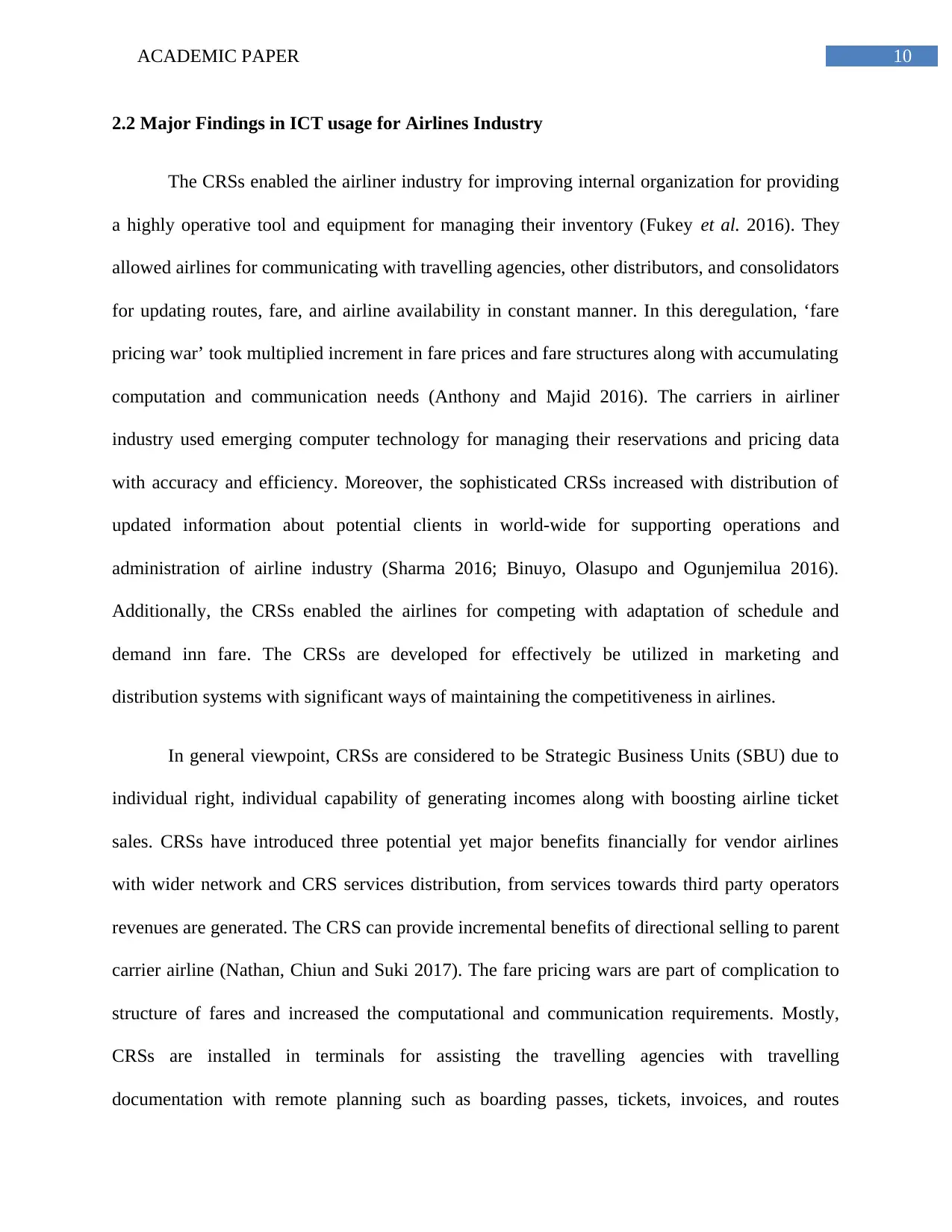
10ACADEMIC PAPER
2.2 Major Findings in ICT usage for Airlines Industry
The CRSs enabled the airliner industry for improving internal organization for providing
a highly operative tool and equipment for managing their inventory (Fukey et al. 2016). They
allowed airlines for communicating with travelling agencies, other distributors, and consolidators
for updating routes, fare, and airline availability in constant manner. In this deregulation, ‘fare
pricing war’ took multiplied increment in fare prices and fare structures along with accumulating
computation and communication needs (Anthony and Majid 2016). The carriers in airliner
industry used emerging computer technology for managing their reservations and pricing data
with accuracy and efficiency. Moreover, the sophisticated CRSs increased with distribution of
updated information about potential clients in world-wide for supporting operations and
administration of airline industry (Sharma 2016; Binuyo, Olasupo and Ogunjemilua 2016).
Additionally, the CRSs enabled the airlines for competing with adaptation of schedule and
demand inn fare. The CRSs are developed for effectively be utilized in marketing and
distribution systems with significant ways of maintaining the competitiveness in airlines.
In general viewpoint, CRSs are considered to be Strategic Business Units (SBU) due to
individual right, individual capability of generating incomes along with boosting airline ticket
sales. CRSs have introduced three potential yet major benefits financially for vendor airlines
with wider network and CRS services distribution, from services towards third party operators
revenues are generated. The CRS can provide incremental benefits of directional selling to parent
carrier airline (Nathan, Chiun and Suki 2017). The fare pricing wars are part of complication to
structure of fares and increased the computational and communication requirements. Mostly,
CRSs are installed in terminals for assisting the travelling agencies with travelling
documentation with remote planning such as boarding passes, tickets, invoices, and routes
2.2 Major Findings in ICT usage for Airlines Industry
The CRSs enabled the airliner industry for improving internal organization for providing
a highly operative tool and equipment for managing their inventory (Fukey et al. 2016). They
allowed airlines for communicating with travelling agencies, other distributors, and consolidators
for updating routes, fare, and airline availability in constant manner. In this deregulation, ‘fare
pricing war’ took multiplied increment in fare prices and fare structures along with accumulating
computation and communication needs (Anthony and Majid 2016). The carriers in airliner
industry used emerging computer technology for managing their reservations and pricing data
with accuracy and efficiency. Moreover, the sophisticated CRSs increased with distribution of
updated information about potential clients in world-wide for supporting operations and
administration of airline industry (Sharma 2016; Binuyo, Olasupo and Ogunjemilua 2016).
Additionally, the CRSs enabled the airlines for competing with adaptation of schedule and
demand inn fare. The CRSs are developed for effectively be utilized in marketing and
distribution systems with significant ways of maintaining the competitiveness in airlines.
In general viewpoint, CRSs are considered to be Strategic Business Units (SBU) due to
individual right, individual capability of generating incomes along with boosting airline ticket
sales. CRSs have introduced three potential yet major benefits financially for vendor airlines
with wider network and CRS services distribution, from services towards third party operators
revenues are generated. The CRS can provide incremental benefits of directional selling to parent
carrier airline (Nathan, Chiun and Suki 2017). The fare pricing wars are part of complication to
structure of fares and increased the computational and communication requirements. Mostly,
CRSs are installed in terminals for assisting the travelling agencies with travelling
documentation with remote planning such as boarding passes, tickets, invoices, and routes

11ACADEMIC PAPER
(Deepa and Jayaraman 2017). The CRSs have improved efficiencies of making arrangements for
sales of settlement between airlines and travelling agencies for empowering frequency of flyer
programs. Moreover, individual airline that is developed or purchased with individual systems is
found out to be the airlines that run domestically or serving national market.
2.3 ICT Implementation in Different Airlines Organizations
During mid-1980s, CRS and airline executives have realized that air transportation is
considered to be smaller part of complex traveling experience. Blessing and Abubakar Umar
(2017) opined that travelling agencies demanded for accessing number of carriers in single
terminal for information sharing in value-added products to certain destinations. The CRSs can
be developed with several comprehensive Global Distribution Systems (GDSs) so that multiple
ranges of tourism products can be offered such as rental cars, hotel reservations, and others. On
the contrary, Gasic, Ivanovic and Peric (2016) stated that single CRS systems namely SABRE
has developed their databases or including the itineraries and inventory management from other
airlines when two different groups of scheduled airlines emerged for Europe to develop Galileo
and Amadeus GDSs. The implemented GDSs can provide supportive and backbone mechanism
for communicating with principals and travelling agencies’ heads (Anthony and Majid 2016).
The travelling agencies held millions of fare pricing data in their databases with including 40
million changes or updates being inserted in each month. Moreover, GDSs implemented a
certain capacity for handling more than 500,000 passengers with individual names, records, and
resending appropriately 2,000 messages in each second.
From early 1990, the GDSs are considered as travelling supermarkets with offering major
reservation of information and data with capabilities for overall range of travel products. The
(Deepa and Jayaraman 2017). The CRSs have improved efficiencies of making arrangements for
sales of settlement between airlines and travelling agencies for empowering frequency of flyer
programs. Moreover, individual airline that is developed or purchased with individual systems is
found out to be the airlines that run domestically or serving national market.
2.3 ICT Implementation in Different Airlines Organizations
During mid-1980s, CRS and airline executives have realized that air transportation is
considered to be smaller part of complex traveling experience. Blessing and Abubakar Umar
(2017) opined that travelling agencies demanded for accessing number of carriers in single
terminal for information sharing in value-added products to certain destinations. The CRSs can
be developed with several comprehensive Global Distribution Systems (GDSs) so that multiple
ranges of tourism products can be offered such as rental cars, hotel reservations, and others. On
the contrary, Gasic, Ivanovic and Peric (2016) stated that single CRS systems namely SABRE
has developed their databases or including the itineraries and inventory management from other
airlines when two different groups of scheduled airlines emerged for Europe to develop Galileo
and Amadeus GDSs. The implemented GDSs can provide supportive and backbone mechanism
for communicating with principals and travelling agencies’ heads (Anthony and Majid 2016).
The travelling agencies held millions of fare pricing data in their databases with including 40
million changes or updates being inserted in each month. Moreover, GDSs implemented a
certain capacity for handling more than 500,000 passengers with individual names, records, and
resending appropriately 2,000 messages in each second.
From early 1990, the GDSs are considered as travelling supermarkets with offering major
reservation of information and data with capabilities for overall range of travel products. The
⊘ This is a preview!⊘
Do you want full access?
Subscribe today to unlock all pages.

Trusted by 1+ million students worldwide
1 out of 49
Related Documents
Your All-in-One AI-Powered Toolkit for Academic Success.
+13062052269
info@desklib.com
Available 24*7 on WhatsApp / Email
![[object Object]](/_next/static/media/star-bottom.7253800d.svg)
Unlock your academic potential
Copyright © 2020–2025 A2Z Services. All Rights Reserved. Developed and managed by ZUCOL.




